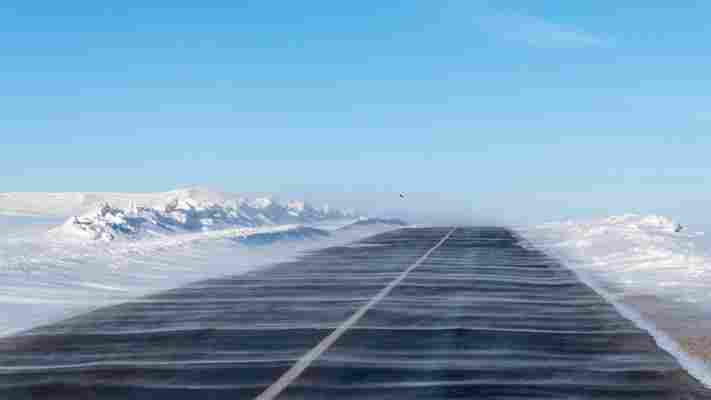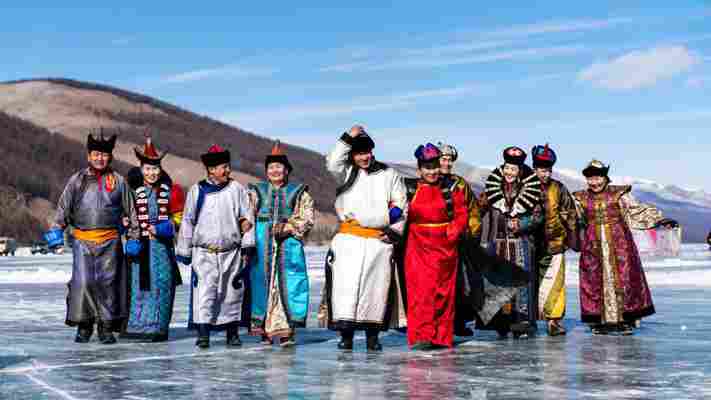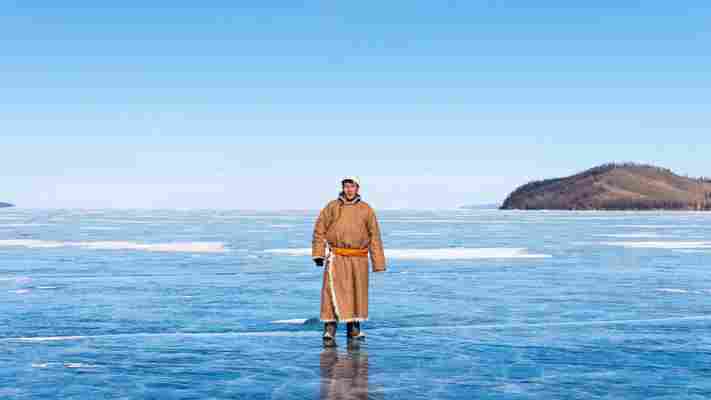

Much of Mongolia’s rugged landscape consists of wide, grass-covered plains called steppes
Leaving traffic-choked Ulaanbaatar, where about half of Mongolia’s three million citizens live, feels like a trip to another planet. On the outskirts of the country’s biggest city, residential buildings and factories quickly give way to deserted moonscapes that stretch toward the horizon. The Land of the Eternal Blue Sky, as Mongolia is often called, is cloudless most of the year. But this abundance of sunshine can be deceiving. Much of Mongolia’s rugged landscape consists of wide, grass-covered plains called steppes, which, uncluttered by trees or manmade structures, allow gales to sweep across the land. The weather can be especially treacherous in winter when Siberian winds from the north bring in exceedingly cold air and temperatures regularly dip below -40C. (Credit: Yulia Denisyuk)

Lake Khövsgöl is Mongolia’s largest freshwater lake by area
Located in Northern Mongolia near the Russian border, Lake Khövsgöl is the country’s largest freshwater lake by area, stretching across 2,620 sq km and measuring 244m at its deepest point. Its crystalline waters have earned it the nickname ‘the blue pearl of Mongolia’, although for at least six months of the year the lake is encased in several metres of ice strong enough to hold people, livestock and even vehicles.Before starting their day on the ice, the residents of Khövsgöl climb atop a sacred rock to pay respect to the lake’s spirit. Once the spirit of Lake Khövsgöl has been appeased, the ice is deemed safe to step on. (Credit: Yulia Denisyuk)
Mongolia's Lake Khövsgöl looks frozen, but the ice is a living, breathing thing
In the stillness of the morning, the air here is filled with popping and cracking sounds. The surface of Lake Khövsgöl looks permanently frozen, but the ice is a living, breathing thing. As it melts during the day’s warmer temperatures, the ice blanket expands, causing pressure cracks in the surface that refreeze once the sun sets, forming a complex web-like pattern. (Credit: Yulia Denisyuk)
Mongolia is roughly the size of Western Europe but with nearly 130 times fewer residents
Mongolia is roughly the size of Western Europe but with nearly 130 times fewer residents, making it the least densely populated country in the world. Life outside the urban areas remains close to how it was centuries ago when wild horses roamed seemingly endless grass pastures. The growing copper, coal and precious metal mining industries have transformed the economy over the past few decades, but agriculture and herding remain a cornerstone of Mongolian life. Families of the steppe rely upon livestock for their income, transport, food and survival. (Credit: Yulia Denisyuk)
Many herding families in Mongolia live a semi-nomadic lifestyle
Many herding families live a semi-nomadic lifestyle, steering their herds of horses or reindeer to fertile pastures while staying close to a village for healthcare and other community needs. With winds prevalent throughout the winter, herders try to base themselves in a calm spot in a valley or near a hill through the season.The peripatetic way of life would hardly be possible without a ger, the nomadic Mongolians’ portable home. The circular shape helps insulate the ger from the continuous winds and warm it evenly with the heat from a wood-burning stove, the home’s physical and spiritual centre. The ger is designed so that a group of five people can assemble it in about an hour, allowing families to move as quickly and often as their herds require. (Credit: Yulia Denisyuk)
Horses are an indelible part of the Mongolian identity
Horses, in particular, are an indelible part of the Mongolian identity. With no fences and enclosures to keep them captive, domestic horses live in herds, moving freely from pasture to pasture. In tough winter months, survival of the animals preoccupies many minds. While conditions known as dzuds – when the summer drought and the subsequent winter freeze drastically reduce viable pasture land – used to be a once-a-decade occurrence, in recent years they have increased in frequency and severity. (Credit: Yulia Denisyuk)
Mongolians from across the country travel to Lake Khövsgöl for the Khövsgöl Ice Festival
Despite the difficulties they face, the people find ways to honour the winter months and celebrate their survival. Every March as spring approaches, Mongolians from across the country travel to Lake Khövsgöl for the Khövsgöl Ice Festival. Getting here is not an easy feat. Few paved roads exist. Much of the distance is traversed through bumpy tracks with no signposts to guide the way. Armed with a thermos of tsai – a mix of water, milk, black or green tea and a dash of salt – and a satchel of fresh, deep-fried khuushuur (a type of meat pastry), families gather on the metres-deep ice to celebrate the end of the most challenging part of the year. (Credit: Yulia Denisyuk)
The Khövsgöl Ice Festival has been gaining popularity with tourists
The festival has been gaining popularity with tourists in recent years. Over the course of two days, attendees can observe – and participate in – traditional Mongolian pastimes. On the first day of the festival, horse-drawn sleighs scurry across the frozen lake and guests compete in traditional games such as tug-of-war and archery. The second day is reserved for large competitions like horse-sleigh races and ice-sculpture carving. (Credit: Yulia Denisyuk)
Festival attendees hail from different Mongolian provinces, tribes and religious beliefs
Hailing from different provinces, tribes, ethnic groups and religious beliefs, visitors settle in gers on and around the lake, coming together to celebrate the profound respect for nature that unites them. Despite the difficulties faced during the winter months, the mood is joyous. At night, before the shaman summons the crowd to the ceremonial fire, participants gather around tables bursting with snacks like aaruul (dried cheese curd) and boortsogs (puffy fried dough). Plenty of tsai is consumed and bowls of fermented mare’s milk, airag, are passed around in a circle. As the night outside gets progressively colder, inside the gers, the atmosphere is warm. (Credit: Yulia Denisyuk)

Leave a Reply